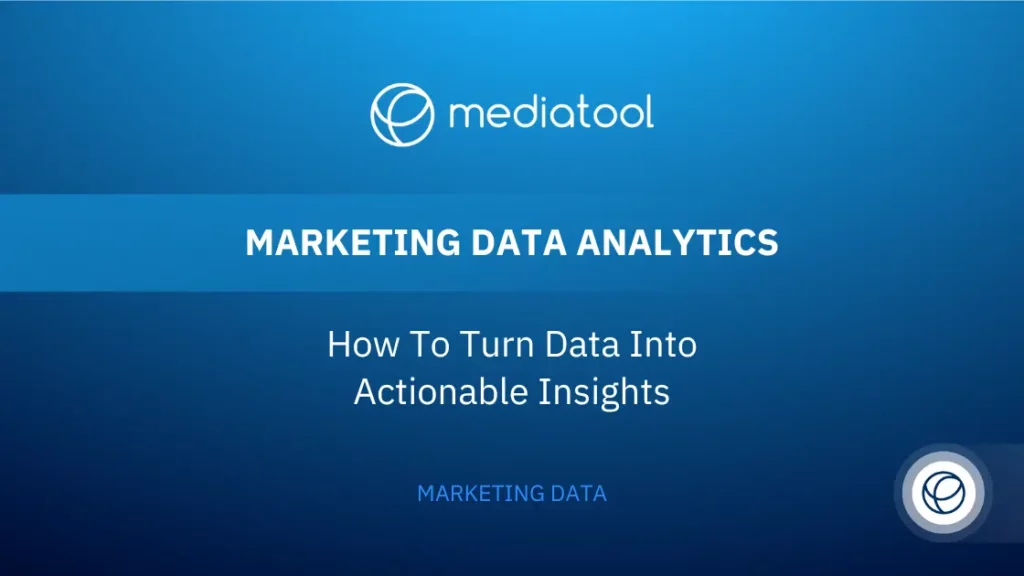Diving into the market without marketing data analytics is risky.
Businesses face the challenge of making sense of vast amounts of data, which can lead to guesswork and missed opportunities.
The key to success?
Marketing data analytics.
This article will show you how to turn challenges into opportunities with the right analytics approach.
What is Marketing Data Analytics and Why Do You Need It?
Marketing data analytics focuses on analyzing data to comprehend customer behavior, assess marketing campaigns, and inform decisions with data.
Marketing data analytics serves as a tool in digital marketing, directing your decisions with factual information rather than assumptions.
Why is it necessary?
The reasons are straightforward.
It helps you remain competitive, understand your target audience, and maximize your marketing budget.
It goes beyond merely gathering customer data; it’s about transforming it into actionable insights promoting growth.

The Importance of Data Analytics in Marketing
Understanding Your Market Through Analytics
Marketing data analytics is used for understanding effective strategies and identifying areas for improvement. By gathering data from various marketing channels, companies achieve a comprehensive perspective on their marketing endeavors.
This insight is key for fine-tuning marketing strategies, enhancing customer engagement, and driving sales upward. Lacking marketing analytics is like moving forward without a clear direction.
Analytics: The Foundation for Strategic Decisions
Marketing analytics serve as the foundation for strategic planning. They allow marketing professionals to harness historical data and customer feedback, turning these into a roadmap for future marketing strategies. This roadmap illuminates the path to improved customer satisfaction and directs marketing budgets more efficiently.
Benefits of Data Analytics in Marketing
Boosting Campaigns and Enhancing Experience
Marketing data analytics significantly elevates marketing campaigns and enhances the customer experience.
With marketing data analysis, businesses uncover key metrics like customer acquisition costs and customer lifetime value.
These metrics are gold mines for gaining insights into consumer behavior, leading to more impactful marketing initiatives and smarter ad spend.
Crafting Future-Proof Strategies
The insights from data analytics models are not just about the present. They equip marketing teams to forecast and shape future marketing strategies.
For instance, analyzing social media data and customer support analytics offers a peek into potential customers’ needs and preferences. This foresight enables businesses to stay ahead, ensuring a competitive advantage in the ever-evolving marketplace.
From Data to Decisions
At its core, marketing data analytics transforms raw data into valuable insights. It’s about interpreting data through statistical analysis and meaningful analytics.
These insights guide the marketing team in fine-tuning marketing efforts, from tailoring digital marketing campaigns to optimizing the sales funnel.
The result?
A more targeted approach to reaching potential customers and a strategic marketing budget allocation.
By integrating business analytics and focusing on consumer behavior through social media posts and beyond, companies can craft marketing campaigns that resonate.
It’s about making every dollar of the marketing spend count and ensuring that marketing efforts translate into real-world success. With marketing data analytics, the goal is always clear: to connect, engage, and convert with precision and insight.
The Challenges of Marketing Data Analytics
In the modern marketing landscape, the journey through marketing data analytics is filled with challenges. These hurdles can make or break a marketing strategy, affecting everything from brand recognition to the effectiveness of a marketing campaign.
Overwhelmed by Data
First and foremost is the challenge of managing an overwhelming amount of data. In an era where collecting data is easier than ever, marketing teams find themselves drowning in a sea of numbers and trends.
The key to navigating this sea is not just in collecting but in identifying reliable data. This step is critical for analyzing marketing data efficiently and effectively.
Ensuring Data Quality
The quality of data is another significant challenge. Reliable data is the cornerstone of gaining insights that are actionable and trustworthy.
Poor quality data can mislead marketing strategies, leading to decisions that might harm rather than help. Establishing rigorous processes for data collection and validation ensures that the insights drawn are based on accurate and reliable data.
Silos and Integration Issues
Data silos within organizations further complicate the marketing analytics process. When information is trapped in departmental silos, it becomes challenging to get a holistic view of the customer journey.
This fragmented view hampers the ability to interpret data effectively, making it difficult to craft cohesive future campaigns. Additionally, employees spend an average of 12 hours each week searching for data due to these silos.
Additionally, the integration of third-party data presents its own set of challenges. Many analytics tools struggle to seamlessly incorporate external data, making it challenging to gain a complete understanding of customer insights and key marketing metrics like average order value.
Interpreting Data Correctly
Perhaps one of the most daunting tasks is interpreting data correctly. The marketing analytics process is not just about numbers; it’s about what those numbers signify.
It requires a blend of skill, experience, and intuition to translate complex datasets into meaningful customer insights that can inform a marketing campaign.
To effectively tackle these challenges, marketing teams need to adopt a strategic approach. This involves investing in the right analytics platforms that can handle large volumes of data, ensure data quality, break down silos, and integrate third-party information.
Only then can businesses fully leverage marketing data analytics to refine their marketing strategy, enhance brand recognition, and successfully navigate the modern marketing landscape.
How to Use Data Analytics in Marketing
Setting the Stage with Clear Goals
The first step in leveraging data analytics in marketing is defining clear, measurable marketing goals. These goals set the direction for your marketing strategy and guide the analytics process.
Whether it’s increasing brand recognition, boosting customer engagement, or optimizing marketing spend, your goals should dictate the data you collect and the insights you seek.
Systematic Data Collection Across Channels
Collecting data is next, and it’s crucial to approach this systematically. This means gathering information from every touchpoint in the customer journey, across all marketing channels. Google Analytics and other web analytics tools are pivotal here.
They track everything from customer behavior on your website to engagement levels on social media platforms. This comprehensive data collection is the foundation for all subsequent analysis.
Deep Diving into Data Analysis
With a robust dataset in hand, the focus shifts to analyzing the data. This stage is where the magic happens. By dissecting customer behavior patterns and identifying customer trends, you start to gain insights into what motivates your audience.
Predictive analytics come into play, offering forecasts that inform future marketing strategies. These predictions can be about anything from customer retention rates to changes in customer lifetime value, guiding you in making informed decisions.
Visualizing Data for Better Understanding
Data visualization tools play a critical role in translating complex data analysis into clear, accessible visuals. These tools create graphs and charts that encapsulate key metrics and trends, making it easier to share valuable insights with your team or stakeholders.
Visual representations help bridge the gap between raw data analysis and strategic decision-making, ensuring everyone is on the same page.
Embracing the Cyclical Nature of Analytics
It’s essential to recognize that marketing data analytics is an ongoing cycle, not a one-time effort. The marketing landscape and consumer behavior are always evolving, and your analytics process should evolve too.
Regular reviews of your analytics strategy ensure that your marketing efforts are continually refined and realigned with your evolving target market and business objectives. This cyclical approach ensures that your marketing remains dynamic, responsive, and, most importantly, effective.
By following these steps, businesses can harness the full power of data analytics in marketing, transforming data into actionable insights that drive decision-making and strategy.
This approach not only enhances current marketing initiatives but also lays the groundwork for future success, ensuring that marketing strategies remain agile, informed, and aligned with the company’s goals and the ever-changing market dynamics.
Conclusion
Marketing data analytics is an indispensable tool in the digital age, offering a roadmap to navigate the complexities of modern marketing. Businesses can optimize their marketing strategies, enhance customer engagement, and achieve significant growth by setting clear goals, systematically collecting data, analyzing patterns, visualizing insights, and embracing the cyclical nature of analytics.
The journey through data analytics is not without its challenges, but with the right approach and tools, the rewards are substantial.
As we move forward, the ability to harness the power of marketing data analytics will continue to be a critical determinant of success in the competitive marketing landscape.





